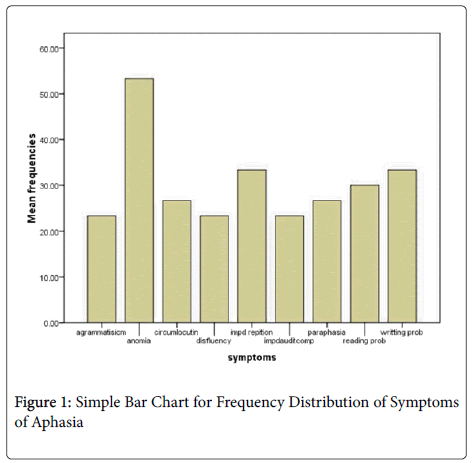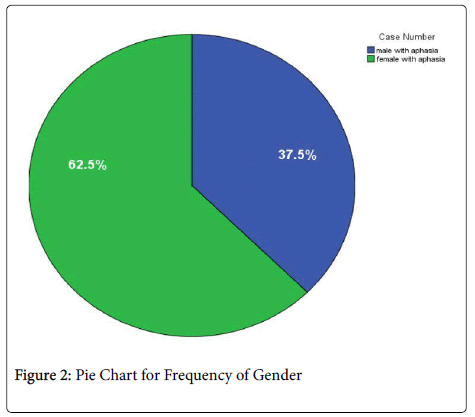Research Article Open Access
Frequency of Aphasia and Its Symptoms in Stroke Patients
Azka Azhar1*, Shazia Maqbool2, Ghazal Awais Butt3, Shamazia iftikhar1, and Ghousia Iftikhar21Bahria Town Hospital, Lahore, Pakistan
2Children Hospital, Lahore, Pakistan
3Autism Resource Centre, Lahore, Pakistan
- *Corresponding Author:
- Azka Azhar
Bahria Town Hospital Lahore, Pakistan
Tel: 0331-4962214
E-mail: azkaazhar27@hotmail.com
Received date: October 10, 2016; Accepted date: November 15, 2016; Published date: November 21, 2016
Citation: Azhar A, Shazia Maqbool S, Butt G, Iftikhar S, Iftikhar G (2017) Frequency of Aphasia and Its Symptoms in Stroke Patients. J Speech Pathol Ther 2:121. doi:10.4172/2472-5005.1000121
Copyright: © 2016 Azhar A, et al. This is an open-access article distributed under the terms of the Creative Commons Attribution License, which permits unrestricted use, distribution, and reproduction in any medium, provided the original author and source are credited.
Visit for more related articles at Journal of Speech Pathology & Therapy
Abstract
Background: Every human uses language. Language is composed of understanding, expressing, finding the right words, reading and writing. If the damage occurs in language areas in the brain, then it can cause aphasia. Aphasia is a pure language disorder includes understanding, expression, writing and reading difficulties. Aphasia usually occurs suddenly, often as the termination of a head injury or stroke, but it may also grow slowly, as in the case of an infection, dementia and brain tumour. The disorder impairs the expression and understanding of language as well as reading and writing.
Objective: To determine the frequency of aphasia and its symptoms in stroke patients.
Material and methods: A cross sectional survey was conducted through questionnaire from Department of Neurology of Mayo, Sheikh Zayed, Lahore general and Jinnah hospital Lahore during January 2013 to June 2013. A sample of 162 Stroke patients was included in the study. The demographic details of the patients are male and female gender, age range between 25-70 years. A questionnaire was filled out based on history and clinical observation. All the collected data were entered into SPSS (statistical package for social sciences) for analysis.
Results: The results indicated that 54.3% stroke patients have aphasia. Out of 162 patients 88 (54.3%) had aphasia and 74 (45.7%) had no aphasia. Among 88 patients of aphasia, 33 (37.5%) were male and 55 (62.5%) were females. Out of 88 aphasic patients 53.3% had Anomia, 33.30% had confronted repetition, 26.7% had Paraphasia, and 23.3% had Agrammaticism and other associated problems were disfluency, circumlocutions, reading and writing problems.
Conclusion: The results of this study showed that the frequency of aphasia is 54.3% in stroke patients.
Keywords
Stroke; Aphasia; Anomia; Paraphasia; Agrammaticism; Disfluency; Circumlocutions
Introduction
Aphasia can be defined as an acquired language disorder that occurs due to brain damage. The brain damage areas involve language expression and reception. Aphasia usually effects production and understanding of language. Aphasia also includes reading and writing difficulties [1]. Most people who acquire aphasia are in late or middle years. A stroke occurs when the brain is unable to receive blood supply. The co-occurrence of aphasia in speech disorder that also occurs due to brain damage includes apraxia and dysarthria [2].
There are two types of aphasia fluent aphasia and non-fluent aphasia. Some of the most common causes of aphasia are traumatic brain injury, epilepsy, stroke, and migraine [3]. The general symptoms of aphasia are paraphasia, disfluency, impaired comprehension, confronted repetition, anomia, reading and writing problems [4] Aphasia therapy improves person communication by helping the individual to restore his remaining language abilities as much as possible to compensate language problems [5]. Aphasia therapy includes both individual and group therapy. Individual therapy based on the specific needs of the individuals while group therapy focuses on the usage of new communication skills in a group [6].
A study carried out on natural history and associated deficits of aphasia after stroke. The symptoms were evaluated over different times during the study. After 6 months of stroke 12% patients have aphasia. There is a high relation between early and late aphasia scores [7].
A cohort study conducted on aphasia in patients of ischemic stroke. The purpose of the study is to determine the prevalence and characteristics of aphasia in ischemic stroke patients. The study showed that 42.4% patients have aphasia after ischemic stroke [8].
The present study is aimed to find out the frequency of aphasia in stroke patients. The study will evaluate the symptoms of aphasia in stroke patients. No study has been conducted in Pakistan on frequency of aphasia in stroke patients. The basic aim of the study is to determine the frequency of aphasia in stroke patients.
Methodology
The purpose of this research is to determine the frequency of aphasia in stroke patients. A cross sectional survey design was selected for this purpose. Simple random sampling was done. The stroke patients were selected from the neurology department of mayo, Sheikh zayed, Lahore general and Jinnah hospital Lahore during January 2013 to June 2013. Estimated stroke population in Pakistan is close to 250 per 100,000 populations. Based on stroke population in Pakistan, with 95% confidence level and 5% confidence interval Sample size of 162 stroke patients was taken [9]. They were selected on the basis of inclusion criteria. An inclusion criterion of the study was equal male and female gender of age ranges between 25-70 years having acute stroke.
A questionnaire developed from literature review and expert’s opinion was used from Assessment in speech language pathology a resource manual [10]. It includes medical history and aphasia symptoms. On the basis of data collected analysis was done with SPSS 16 to determine the frequency of aphasia in stroke patients.
Results
This observational study was based on 6 months’ time period and 162 patients of stroke were studied. A questionnaire was used for each patient, which was filled out based on history and clinical observation.
The percentage and frequency of aphasia in 162 patients of stroke is 88 (54.3%) had aphasia and 74 (45.7%) had no aphasia (Table 1).
| Diagnosis | Frequency |
|---|---|
| Aphasia is absent | 74 (45.7%) |
| Aphasia is present | 88 (54.3%) |
Table 1: Frequency Distribution of Aphasia in Stroke Patients (n=30)
Table 2 shows the cross tabulation between age and diagnosis. The 22 (40.7%) aphasia patients had age ranges between 25-40 years, 26 (48.1%) patients had age ranges between 40-55 years and 40 (74.0%) patients had age ranges between 55-70 years
| Count | Diagnosis | ||
|---|---|---|---|
| Aphasia is absent | Aphasia is present | ||
| Age | 25-40 years | 32 (59%) | 22 (40.7%) |
| 40-55 years | 28 (51%) | 26 (48.1%) | |
| 55-70 years | 14 (25%) | 40 (74.0%) | |
| Total | 162 patients | 74 (45.6%) | 88 (54.3%) |
Table 2: Cross Tab Age and Diagnosis. Age * Diagnosis Cross Tabulation.
The simple bar chart shows the frequency of symptoms of aphasia. The 53.30 % aphasic patients had anomia, 33.30 % had confronted repetition, 33.30% had writing problems, 30% had reading problems, 26.70% had paraphasia, 23.30% had impaired auditory comprehension, 23.30% had disfluency, 23.30% had agrammaticism and 26.70% had circumlocution (Figure 1).
Out of 81 male patients 33 had aphasia and 48 had no aphasia and out of 81 female patients 55 had aphasia and 26 had no aphasia (Figure 2).
Discussion
The 162 stroke patients are included in study from different hospitals in Lahore Pakistan. Most female stroke patients are aphasic. Most common symptoms of aphasia are anomia, impaired repetition, grammaticism, writing problems and disfluency. Mostly people having problem in naming.
A research was conducted by Brust in 2001, on aphasia in acute stroke and its relation to outcome. The degree and type of aphasia are also assessed. Results showed that about one third stroke patients had aphasia [11]. A research by Brust correlate with the results of this study which showed that 54.3% stroke patients had aphasia.
Another study conducted on relationship between the presence of aphasia and the severity of the stroke also supported the results of this study. The relationship between aphasia and severity of the stroke is assessed by other measures such as loss of functional independence. Findings indicated as aphasia occurred in about one quarter of conscious patients soon after stroke [12].
A prospective study is conducted on incidence of aphasia in acute stroke and its recovery. Assessment of aphasia was done at the time of admission, weekly, and after 6 months. Results showed that Fifty four percent had aphasia at the time of admission and 38% had aphasia at the time of discharge [13]. The prospective study also supported the results of this study which showed that 54.3% stroke patients had aphasia.
A prospective study conducted by Kenneth in 2002 on relationship between stroke and aphasia. The most common symptom of aphasia seen after stroke is anomia. The second most common symptom is impaired repetition [14]. This prospective study supports the results of this study which showed that most common symptom of aphasia is anomia.
Conclusion
It was concluded from the study that aphasia was present in half of the sample population. Aphasia is more in female than male. It is more common in age group of 55-70 years.
References
- Basso A (2003) Aphasia and its therapy. Oxford Univ Press.
- Kenneth Shipley JM (2009) Assessment in Speech-Language Pathology: A Resource Manual. Unitdelmar Cengage Learning.
- Weisenburg TH, McBride KE (1964) Aphasia, a Clinical and Psychological Study: A Clinical and Psychological Study. Hafner Pub Co.
- Stephen E, Nadeau LJR (2000) Aphasia and language theory to practice. Guilford.
- Kertesz A (1979) Aphasia and associated disorders: Taxonomy, localization, and recovery. Holt Rinehart & Winston.
- Association ash. aphasia treatment.
- Wade D, Hewer RL, David RM, Enderby PM (1986) Aphasia after stroke: natural history and associated deficits. J Neurol Neurosurg Psychiatry 49: 11-16.
- Inatomi Y, Yonehara T, Omiya S, Hashimoto Y, Hirano T (2008) Aphasia during the acute phase in ischemic stroke. Cerebrovascu Dis 25: 316-323.
- Engelter ST, Gostynski M, Papa S, Frei M, Born C, Ajdacic-Gross V, et al. (2006) Epidemiology of aphasia attributable to first ischemic stroke incidence, severity, fluency, etiology, and thrombolysis. Stroke 37:1379-1384.
- http://www.calculator.net/sample-size-calculator.html.
- Brust J, Shafer S, Richter R, Bruun B (1976) Aphasia in acute stroke. Stroke 7: 167-174.
- Pedersen PM, Stig Jørgensen H, Nakayama H, Raaschou HO, Olsen TS (1995) Aphasia in acute stroke: incidence, determinants, and recovery. Ann Neurol 38: 659-666.
- Pedersen P, Vinter K, Olsen TS (2004) Aphasia after stroke: type, severity and prognosis. Cerebrovasc Dis 17: 35-43.
- Heilman KM, Safran A, Geschwind N (2004) Stroke and aphasia. J Neurol Neurosurg Psyc 34: 265-9.
Relevant Topics
- Stuttering therapy
- Active listening
- Aphasia
- Articulation disorders:
- Autism Speech Therapy
- Bilingual Speech pathology
- Clinical Linguistics
- Communicate Speech pathology
- Interventional Speech Therapy
- Late talkers
- Medical Speech pathology
- Spectrum Pathology
- Speech and Language Disorders
- Speech and Language pathology
- Speech Impediment / speech disorder
- Speech pathology
- Speech Therapy
- Speech Therapy Exercise
- Speech Therapy for Adults
- Speech Therapy for Children
- Speech Therapy Materials
Recommended Journals
Article Tools
Article Usage
- Total views: 8777
- [From(publication date):
February-2017 - Aug 28, 2025] - Breakdown by view type
- HTML page views : 7652
- PDF downloads : 1125

